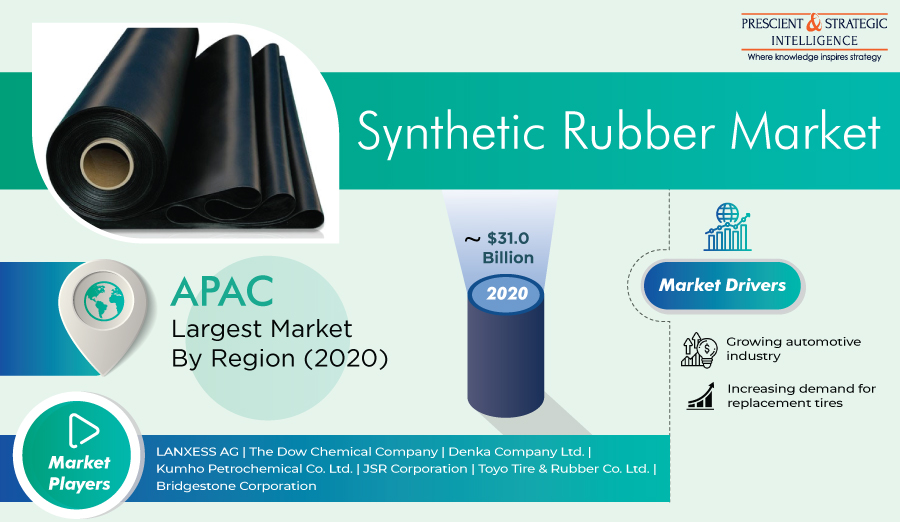The global synthetic rubber market revenue stood at $31.0 billion in 2020, and the market is expected to exhibit huge expansion in the coming years. The market is being propelled by the rising demand for automotive tires, mushrooming requirement for long-lasting rubber, ballooning production capacity of many rubber manufacturers, and surging investments being made by them. Additionally, the booming automotive industry and the implementation of initiatives by several governments for increasing disposable income of citizens, facilitating industrialization, and fueling economic progress are also driving the market.
The soaring manufacturing and sales of automobiles, especially in developing nations, such as India and China, is fueling the expansion of the automotive industry. For instance, as per the India Brand Equity Foundation (IBEF), the automotive industry in India is predicted to reach a revenue of INR 16.16-18.18 trillion (US$ 251.4-282.8 billion) by 2026. As rubber and rubber products are extensively used in the automobile industry in various applications, such as body sealing systems, vehicle anti-vibration systems, suspension systems, fluid transport systems, fused components, flat seals, O rings, and adhesives and sealants, the surge in the industry is positively impacting their demand.
Browse detailed report on Global Synthetic Rubber Market Latest Trends and Business Scenario 2030
In addition, many components in the engine compartment, such as engine seals and hoses in air conditioning systems, are produced from high-grade synthetic rubber. Owing to these factors, the expansion of the automotive industry is propelling the synthetic rubber market across the globe. Depending on product type, the market is divided into polybutadiene rubber (BR), butyl rubber (IIR), acrylonitrile-butadiene rubber (NBR), styrene-butadiene rubber (SBR), ethylene-propylene-diene rubber (EPDM), and styrene block copolymer (SBC).
Amongst these, the SBR category contributed the highest revenue to the market in the past, and it will demonstrate rapid expansion in the upcoming years as well, according to the market research firm, P&S Intelligence. This is credited to the abrasion resistance of SBR, which is desirable in the healthcare, footwear, and building and construction industries. When application is taken into consideration, the synthetic rubber market is classified into footwear, non-tire automotive, tire, adhesives and sealants, industrial components, and paints and coatings. Among these, the tire category dominated the market in 2020, and it is predicted to generate high revenue in the coming years as well.
Download sample pages of this report: https://www.psmarketresearch.com/market-analysis/synthetic-rubber-market/report-sample
This is ascribed to the ballooning requirement for replacement tires, owing to the soaring sales of two-wheelers and four-wheelers all over the world. Geographically, the Asia-Pacific region contributed the highest revenue to the synthetic rubber market in the years gone by. This was because of the high requirement for synthetic rubber in the tire and construction industries. Moreover, leading automakers are rapidly setting up their manufacturing facilities in the APAC countries in order to strengthen their position in the industry. Currently, the automotive industry is surging in China, on account of the growing demand for clean automobiles, which is also fueling the expansion of the regional market.
Hence, the market will exhibit rapid expansion in the forthcoming years, mainly because of the booming sales of automobiles all over the world.
Synthetic Rubber Market Size Breakdown by Segments
By Form Type
- Solid
- Liquid
By Product Type
- Styrene Butadiene Rubber (SBR)
- Butadiene Rubber (BR)
- Styrenic Block Copolymer (SBC)
- Ethylene Propylene Diene Monomer (EPDM) Rubber
- Butyl Rubber (IIR)
- Nitrile Rubber (NBR)
- Others
By Application
- Tire
- Non-Tire Automotive
- Footwear
- Industrial Components
- Adhesives & Sealants
- Paints & Coatings
- Others
By Region
- North America Synthetic Rubber Market
- By form type
- By product type
- By application
- By country – U.S. and Canada
- Europe Synthetic Rubber Market
- By form type
- By product type
- By application
- By country – Germany, France, U.K., Italy, Spain, and Rest of Europe
- Asia-Pacific Synthetic Rubber Market
- By form type
- By product type
- By application
- By country – Japan, China, India, Australia, South Korea, and Rest of APAC
- Latin America Synthetic Rubber Market
- By form type
- By product type
- By application
- By country – Brazil, Mexico, and Rest of LATAM
- Middle East and Africa Synthetic Rubber Market
- By form type
- By product type
- By application
- By country – Saudi Arabia, South Africa, and Rest of MEA
Browse Other Related Reports
Synthetic Fibers Market – Currently, Asia-Pacific dominates the synthetic fibers market, a situation that will stay the same in the coming years. This will be because the region is home to many of the world’s largest producers of apparel, including India, China, Bangladesh, Vietnam, and Hong Kong. Moreover, synthetic fibers are used for automotive upholstery, which is another reason APAC will create the highest demand for them; APAC produces the most vehicles in the world.
Automotive Tire Market – The global automotive tire market was consolidated in nature, with four major players holding around 45% of the tire sales, globally, in 2018. The market was led by Compagnie Générale des Établissements Michelin, which was followed Bridgestone Corporation, The Goodyear Tire & Rubber Company, and Continental AG. The dominance of Compagnie Générale des Établissements Michelin in the world is mainly due to heavy investments by the company, as well as the growing presence of large dealer network across the globe.
Media Contact
Company Name: P&S Intelligence
Contact Person: Abhishek
Email: Send Email
Phone: +918887787886
Address:Noida Sector 2
City: Noida
State: UP
Country: India
Website: https://www.psmarketresearch.com/market-analysis/synthetic-rubber-market

